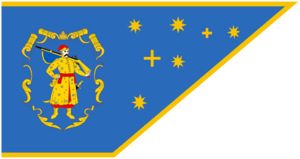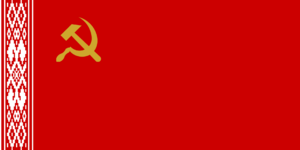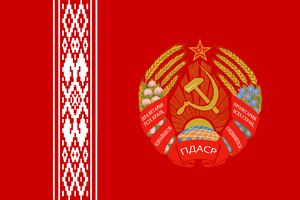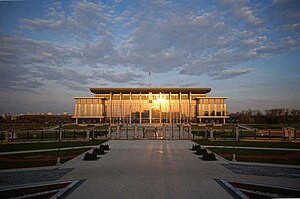North Dniester
United Socialist Republic of North Dniester Аб'яднаная Сацыялістычная Рэспубліка Паўночнага Прыднястроўя | |
|---|---|
| Motto: Прагрэс ёсць шлях да свабоды (Progress is the path to freedom) | |
| Anthem: National Anthem of the United Socialist Republic of North Dniester | |
| Capital and | Tiraspol |
| Official languages | Vestslavisk |
| Demonym(s) | Dniesterian |
| Government | |
• President of the Republic of North Dniester | Vladimir Sukov |
• Prime Minister of the Republic of North Dniester | V. Dokiychuk |
• President of the Congress of Peoples' | Ioseb Jughashvili |
| Legislature | Congress of Peoples' |
| Establishment | |
• 2022 | United Soicalist Repbulic of North Dniester |
| GDP (nominal) | estimate |
• Total | FR400.44 Billion |
• Per capita | FR10914 |
| Currency | Forint (FR) |
| Driving side | left |
| Internet TLD | .dn |
North Dniester or simply Dniester, is bordered by the United Kingdom of Ahrana to the West with the Prymontian Rus being across the Dniestrian Strait and with Sout Dniester being along its southern border. The people of Dniester are split into two States, the United Socialist Republic of North Dniester and the United Provinces of Southern Dniester with the latter being a Member State to the Union of the United Kingdom of Ahrana. North Dniester is a proctortate of the Union of the United Kingdoms of Ahrana after the Dniesterian-Ahranaian War to ensure stablity and proction.
Eythmology
The name Dniester is closely related with the river Dniester. There are several claims to the origin of the name Dniester. An ethno-religious theory suggests that the name used to describe the part of old Minskian lands within the Grand Dutchy of Gdańsk that had been populated mostly by early Christianized Slavs, as opposed to the Kingdom of Słupsk, which was predominantly inhabited by pagan Prymontians.
The name Dniester is often conflated with its Tagmatine forms Russia and Belarus, thus Dniester is often referred to as Belarus or Russia. The name first appeared in Tagmatine medieval literature; the chronicles of Jan of Czarnków mention the imprisonment of Gdańskian grand duke Jogaila and his mother at "Russiae, Poloczk dicto" in 1381. The Tagmantine term "Russia" was used again by the Pope in 1783 to recognize the Society of Jesus there, exclaiming "Approbo Societatem Jesu in Russia degentem, approbo, approbo."
After the Bolshevik Revolution in 1940, the term "Russia" caused some confusion, as it was also the name of the military force that opposed the red Bolsheviks. During the period of the Dniestrian Socialist Republic, the term Russia was embraced as part of the national consciousness.
The term Russia (its names in other languages such as Anglish being based on the Minskian form) was only used officially until 1991, when the Supreme Soviet of the Dniester decreed by law that the new republic should be called the Republic of Dniester as well its abridged form should be "Dniester". The law decreed that all the forms of the new term should be transliterated into other languages from their Dniesterian language forms. The use of Russian SSR and any abbreviations thereof were allowed from 1991 to 1993. Conservative forces in the newly independent Dniester did not support the name change and opposed its inclusion in the 1991 draft of the Constitution of Dniester.
In 2022 with the Ahranaian Incursion into the Unifed Socialist Republic of Dniester, the country was split into two entities after the Ahranaians stablised the country. The Northern part of Dniester was again titled North Dniester with the Sountern Part of Dniester being called South Dniester but as a Member to the Union of the United Kingdom of Ahrana.
History
Early History
From 5000 to 2000 BC, Bandkeramik cultures predominated. In addition, remains from the Dnieper-Doenets culture were found in Dniester. Cimmerians and other pastoralists roamed through the area by 1,000 BC, and by 500 AD, Slavs had taken up residence. Invaders from Alharu, among whom were the Fulgis, swept through c. 400–600 AD, but were unable to dislodge the Slavic presence.
The region that is now Dniester was first settled by Prymontian tribes in the 3rd century. Around the 5th century, the area was taken over by Slavic tribes. The takeover was partially due to the lack of military coordination of the Prymontians but the gradual assimilation of the Prymontians into Slavic culture was peaceful in nature.
Grand Duchy of Gdańsk
During the Grand Duchy era of Dniestrian History as part of the Ahranaian Crown Lands Act the land of Dniester was elevated from a Territory to a Grand Duchy with a Ducal House of its own Independent but in association with the Ahranaian Crown for protection and representation. The House of Volkov, was the ducal line for over one-hundred and fifty years before being elevated the Independent Kingdom Status from the United Kingdom of Ahrana.
Kingdom of Gdańsk
The Kingdom of Gdańsk would last till the Bolshevik Revolution of 1940 with several other uprisings in the years prior to this victorious Revolution. When the Kingdom was elevated and given Independence from the Ahranaian Imperial it was due to several petitions from the Government of Gdańsk which was ignored several times before ultimately the Ahranaian Government gave in or was forced to. The Kingdom would have a trouble history especially with Rebellions and Revolutions happening or attempting to happen, the most known one is the Bolsheviks successful uprising in the 1940s which in part was fueled by the Republicans in Ahrana at the time.
Bolshevik Dniester
In the early days of the Bolshevik or Socialists power in the Government it was a suttle power grab at the start with them sharing the power with other political parties and even the Monarchal Government for a time. It wouldn't be till four years after that the Socialists felt they had enough of a power hold on the country that they completely took over the country and the government and banished the Monarchy and the Royal Family from ever setting foot in Dniester along with the other Political Parties. After the mass expullsion the Socialists started their own agenda creating a Socialist State built on fear and labor.
Modern History
Since 2022 after the Ahranaian Invursion in the then "Unified Socialist Republic of Dniester", the North Dniesterian Population have started to live a more suitable and human form of life with the expulsion of the The Circle, The Circle of Death, and the Ahranaian Terrorist groups that came to power in Dniester. When the Ahranaian Military invaded the then Unified Socialist Republic of Dniester there were two factions of in Dniester, the White Dniesterians fought with the Ahranaians while the Red Dinesterians fought against the invasion. As time went on the People of Dniester saw the atrocities the Reds were committing and soon turned against the Reds and even at times were in the streets with the White Rebels fighting them back. The White Dniestrian's were not Monarchists in any shape or form but instead were supporters of a free Dniester from influence by the terrorist groups. At the end of the invasion and with the withdrawal of the Ahranaian Forces to the Southern Region of Dniester. As the Treaty of Tiraspol stated the country would be divided into two states One Independent of the Ahranaian Crown and free to establish the United Socialist Republic, and the other in union with the Ahranaian Crown as the United Provinces as a member state.
Government and Politics
The Government of the United Socialist Republic of North Dniester is a Federal Parliamentary Republic comprised up of two main groups of peoples, the Northern and Southern Dniestrian People. The Government is a Centrally composed Government based out of the Capital of Tiraspol which is the location of the Executive, Legislative and Judicial Sections of Government that is governed by the Constitution of the United Socialist Republic of North Dniester.
Executive
The Executive branch of the Government of Northern Dniester is made up of the Presidium with a President, Prime Minister, Deputy Minister and the Executive Ministries of the Executive Government. The President and Prime Minister are elected by the people in an Election with the Ministers being appointed by the Prime Minister acknowledged by the Congress of Peoples' and accepted into office by the President.
President
The President of the Republic of Northern Dniester is elected by the people through a secret ballet election for a non-renewable seven-year term as the Head of State that heads the Presidium and the Government. The President also meets and receives all Ambassadors and Envoys from Foreign States at the Presidential Palace while also receiving the Foreign Heads of State and Governments. The President holds the authority to dissolve the Congress of Peoples', issuing Presidential Pardons, Commander-in-Chief of the Armed Forces of Norhtern Dniester and other Presidential Prerogatives.
Prime Minister
The Prime Minister of the Republic is elected by the people through a secret ballet election for a seven-year term renewable three times as the Head of Government that chairs all Government councils within the Presidium. The Prime Minister is nominated by the Political Party within the Congress of Peoples' to stand for Election by the people. The Prime Minister debates all policy and government acts within the Congress of Peoples' to create the unified government policy for Northern Dniester. The Prime Minister creates all Policy in association with the Congress, drafts the Declaration of War for debate in the Congress, and other such prerogatives entitled in the Constitution.
Deputy Minister
The Deputy Minister of the Republic is the second to the Prime Minister who is in essence a shadow minister to the Prime Minister to take over the responsibilities of Prime Minister should the Prime Minister become indisposed, criminally charges, removed from office or other reasons. The deputy minister holds no special authority other then to use their vote in a tie in the Presidium or Congress over Policy or Government Action.
Executive Ministries
The Executive Ministries in the Presidium are nominated by the Prime Minister, confirmed by the Congress of Peoples' and sworn into office and accepted by the President of the Republic to serve in their respected Ministries till removal or change of Prime Minister. The Senior Executive Ministries are:
- Ministry of Justice
- Ministry of Defense
- Ministry of Economy and Trade
- Ministry of Culture
- Ministry of State Security
- Ministry of Foreign Affairs
- Ministry of Internal Affairs
The Executive Ministries are composed of a total of 36 Ministries each with their own Ministers to head these Ministries.
Legislative
The Legislature of the United Socialist Republic of North Dniester is the Unicameral Chamber called the Congress of Peoples'. The Congress is composed up of 350 Members of Congress that are allocated seats by Political Party and Nationality. One Hundred and fifty (150) of the seats are allocated for Nationalities across Dniester and the remaining two hundred (200) seats are allocated by Party Representation on a ballet. Currently the main Political Parties registered with the Electoral Commission of Northern Dniester are the Socialist Party, National Socialist Party, Peoples' Party and the Liberal Socialist Party. The ranking of Political Free Index is seen as low due to the dominance of the Left-winged Political Parties in the Congress.
Judicial
The Judicial of the United Socialist Republic of North Dniester is composed up of the Supreme Court, Peoples' National Court and the Lower Courts of the land all headed by a Panel of five judges nominated by the Government, elected by the people through secret ballet, confirmed by the Congress and sworn into office and accepted for appointment by the President of the Republic. The Procurator of the Socialist Republic also is part of the Judicial Section of the Government.
Military and Law Enforcement
The Armed Forces of the United Socialist Republic of North Dniester are made up of the Army, Navy and Air Force that protect the interests of the Government and People of North Dniester from Foreign and Domestic Threats. The Police or Militsiya are responsible for enforcing the Law in the borders of the Northern Dniester, and they work hand and hand with the Ministry of Justice and State Security.
Army
The Federal Army is the land force of the Military of North Dniester. The Army of Dniester is smaller than its previous size due to the last War with Ahrana and the Independence of South Dniester. The new Army of North Dniester is a combination of Mechanized, Infantry, and Air Groups. The Army is regulated by a limit put in place by the Ahranaian Military to keep the Norhtern Dniesterian in line and out of confrontation with Ahrana.
The Federal Navy is the main Naval Force of the Military of North Dniester, the Navy includes the the Naval Border Patrol and Coast Guard. The Navy is made up of the remaining ships from the Dniesterian-Ahranaian War. Since North Dniester was given full control of all aspects of Society the Ahranaian Naval Yards have made a contract with the Northern Dniesterian Navy to help replace its small Navy and make it more modern.
Militsiya
Economy
The Economy of North Dniester is a mixed economy with some private and public sectors. The Government runs the Public Sector entirely and the Private Sector is closely monitared to ensure no one busniess or groups gain to much economic power to stand up to the government and the people.






